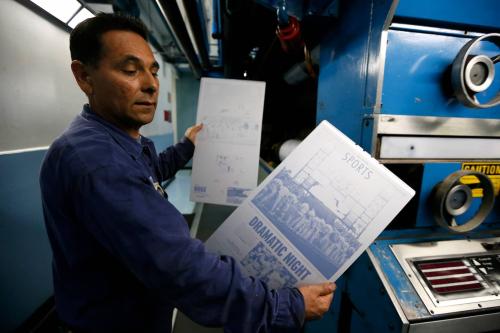To judge by media accounts from last weekend’s Shangri-La Dialogue in Singapore, the United States and China are headed into very troubled waters. Beijing’s accelerated efforts to fortify reefs and shoals in the South China Sea and the U.S. Pacific Command’s surveillance of these activities—including press leaks that China has positioned two “motorized artillery pieces” on an unspecified location in the Spratly Islands—dominated news coverage. For many observers, this action-reaction cycle portends more worrisome possibilities.
Controversy and potential conflict represent the very lifeblood of print journalism and mass media. But policy makers, not media, are responsible for policy, and should not let media coverage or hyper-ventilation dictate their actions. Unfortunately, governments increasingly rely on media to buttress their policy positions and actions. In the run-up to the Shangri-La Dialogue, the U.S. Pacific Command unwisely enlisted CNN in its strategic messaging, and invited a CNN correspondent and camera crew on board the P-8 reconnaissance aircraft. Ample sensitivity and risk attaches to these missions, which (at least historically) U.S. military leaders treated as highly secret. However, the command concluded that the opportunity for widespread publicity—replete with recorded warnings from Chinese personnel for U.S. surveillance to desist from its actions near Beijing’s fortification efforts—was too good to pass up.
Don’t worry, be pacific
Are circumstances as worrisome as some seem to believe? Are the U.S. and Chinese governments equally mindful of the stakes and risks, and how do they propose to manage them? In the Singapore meeting, Secretary of Defense Ashton Carter and China’s Deputy Chief of the General Staff, Admiral Sun Jianguo, presented their respective cases to a large audience of senior officials, scholars, and corporate representatives.
It is doubtful that either Secretary Carter or Admiral Sun changed many minds. Though the tone of both speeches was measured and not designed to inflame sentiment in either capital or in either military, neither budged from well entrenched positions. The United States insisted it was fully within its rights to protect freedom of navigation and overflight and “to fly, sail, and operate wherever international law allows.” China argued that “there has never an issue with freedom of navigation in the South China Sea…these construction projects fall well within the scope of China’s sovereignty and are legitimate, justified and reasonable.”
Both countries insist that their actions accord fully with their respective interpretations of the UN Convention on the Law of the Sea (UNCLOS). The United States unambiguously insists that UNCLOS permits close-in surveillance in a given country’s Exclusive Economic Zone (EEZ) without informing the state in question. China categorically rejects this position, as do some other coastal states, most prominently India.
The U.S. further asserts that it is neither a party to nor does it take a stand with respect to the disputes over sovereignty in the South China Sea. By flying outside a 12 nautical mile limit surrounding these newly fortified positions, the United States appears to tacitly acknowledge China’s physical control of these locations, if not Chinese claims of undisputed sovereignty. Media reports suggest that the U.S. is contemplating reconnaissance missions inside these 12 nautical mile zones, which would deeply agitate China. But the risks of such missions outweigh any potential benefits.
Ominous possibilities
The key question is how far might China’s fortification efforts go? A benign interpretation holds that China is undertaking actions that other claimants have undertaken before them, even though Beijing’s activities over the past eighteen months are much more extensive in scope and scale. Admiral Sun and other Chinese officials insist that China is fulfilling its larger responsibilities for maintaining regional order, including maritime search and rescue, disaster prevention and relief, scientific research, and safety of navigation. By building facilities on multiple locations in the Spratlys, China is creating possibilities that it heretofore lacked.
Though not singling out China by name, Secretary Carter has raised more ominous possibilities. He called for “an immediate and lasting halt to land reclamation by all claimants. We also oppose any further militarization of disputed features.” China is the most capable and most active of any of the claimants, and his message was surely directed first and foremost at Beijing.
But Secretary Carter’s reference to militarization reflects deeper, longer-term U.S. concerns. Will the building of airfields ineluctably lead to the deployment of Chinese military power in newly fortified locations? Admiral Sun argued that the construction efforts are intended “mainly” for improving working and living conditions, with military activity limited to “necessary defense needs.” China has yet to disclose how it conceptualizes its military requirements in the South China Sea. At the same time, the publication of a photograph purportedly revealing two artillery pieces hardly represents a worst case indicator of larger scale deployment of air or naval power in inherently vulnerable locations.
Recent developments do not imply an imminent crisis. But the biggest risk would be if neither the United States nor China sees the need to candidly air their respective concerns to each other and explore the possible means to prevent ugly outcomes. This should be done in private, official conversation, not in international conferences or through exploitation in American or Chinese media. There are multiple opportunities for precisely such discussions in the near-term future, including the impending arrival in the United States of General Fang Fenghui, the ranking general in China’s armed forces; this summer’s Strategic and Economic Dialogue; and (most important) the September visit of China’s President Xi Jinping to Washington, DC.
These pending events should matter very much to both leaderships, but especially to President Obama, as he approaches his final year and a half in office. Where does China fit in the president’s foreign policy legacy? Which way are both countries headed in their longer term relationship, and what can be achieved to bridge potential divides by those with decision making responsibilities? It is to these realities, and not to media needs, that attention must turn without delay.



Commentary
The United States, China, and the South China Sea: Is regional order at risk?
June 3, 2015